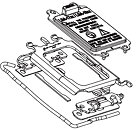
G.SKILL and ASUS Sets New DDR5-8888 CL88 Overclocking World Record
G.SKILL International Enterprise Co., Ltd., the world's leading manufacturer of extreme performance memory and gaming peripherals, is thrilled to announce the achievement of a new overclocking world record for fastest memory frequency at DDR5-8888 CL88-88-88-88, in cooperation with ASUS. This amazing frequency speed was achieved by the extreme overclocker "lupin_no_musume" with G.SKILL Trident Z5 DDR5 memory, ASUS ROG Maximus Z690 APEX motherboard, and Intel Core i9-12900K processor. To see the moment this amazing overclocking world record was set, please click the following video link: https://youtu.be/OgQFbUOs6i8
DDR5-8888 CL88-88-88-88 - Pushing the Speed to the Limit
At the dawn of the DDR5 era, G.SKILL and ASUS have been constantly exploring the memory speed limitations of the latest Intel Z690 platform. Surpassing the previous DDR5-8704 world record in November 2021, a new memory frequency world record is achieved at DDR5-8888 under liquid nitrogen extreme cooling. The memory speed has been validated by CPU-Z. Please refer to the screenshot and validation link below: https://valid.x86.fr/qgvylc
DDR5-8888 CL88-88-88-88 - Pushing the Speed to the Limit
At the dawn of the DDR5 era, G.SKILL and ASUS have been constantly exploring the memory speed limitations of the latest Intel Z690 platform. Surpassing the previous DDR5-8704 world record in November 2021, a new memory frequency world record is achieved at DDR5-8888 under liquid nitrogen extreme cooling. The memory speed has been validated by CPU-Z. Please refer to the screenshot and validation link below: https://valid.x86.fr/qgvylc










































































